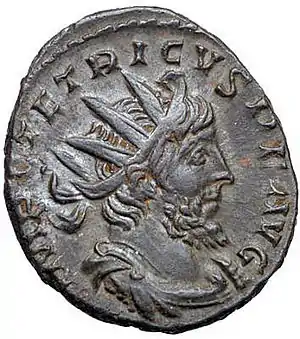274
Year 274 (CCLXXIV) was a common year starting on Thursday (link will display the full calendar) of the Julian calendar. At the time, it was known as the Year of the Consulship of Aurelianus and Capitolinus (or, less frequently, year 1027 Ab urbe condita). The denomination 274 for this year has been used since the early medieval period, when the Anno Domini calendar era became the prevalent method in Europe for naming years.
| Millennium: | 1st millennium |
|---|---|
| Centuries: | |
| Decades: | |
| Years: |
| 274 by topic |
|---|
| Leaders |
|
| Categories |
|
| Gregorian calendar | 274 CCLXXIV |
| Ab urbe condita | 1027 |
| Assyrian calendar | 5024 |
| Balinese saka calendar | 195–196 |
| Bengali calendar | −319 |
| Berber calendar | 1224 |
| Buddhist calendar | 818 |
| Burmese calendar | −364 |
| Byzantine calendar | 5782–5783 |
| Chinese calendar | 癸巳年 (Water Snake) 2970 or 2910 — to — 甲午年 (Wood Horse) 2971 or 2911 |
| Coptic calendar | −10 – −9 |
| Discordian calendar | 1440 |
| Ethiopian calendar | 266–267 |
| Hebrew calendar | 4034–4035 |
| Hindu calendars | |
| - Vikram Samvat | 330–331 |
| - Shaka Samvat | 195–196 |
| - Kali Yuga | 3374–3375 |
| Holocene calendar | 10274 |
| Iranian calendar | 348 BP – 347 BP |
| Islamic calendar | 359 BH – 358 BH |
| Javanese calendar | 153–154 |
| Julian calendar | 274 CCLXXIV |
| Korean calendar | 2607 |
| Minguo calendar | 1638 before ROC 民前1638年 |
| Nanakshahi calendar | −1194 |
| Seleucid era | 585/586 AG |
| Thai solar calendar | 816–817 |
| Tibetan calendar | 阴水蛇年 (female Water-Snake) 400 or 19 or −753 — to — 阳木马年 (male Wood-Horse) 401 or 20 or −752 |

Coin of Tetricus I
Events
Roman Empire
- Battle of Châlons: The Emperor Aurelian invades Gaul to campaign against the Gallic Empire (Gaul and Britain). In the Catalaunian Plains, the Romano-Gallic Emperor Tetricus I surrenders to Aurelian and leaves his army without an emperor. The Gallic army is then crushed by Aurelian in a major battle. With the conquests of the Palmyrene Empire and the Gallic Empire, the Roman Empire is united again. However, the heavy losses incurred by the Gallic forces compromises the Rhine frontier.
- Rome greets Aurelian as Restitutor Orbis ("Restorer of the World") and accords him a magnificent triumph (victory procession), which is graced by his captives Zenobia, Tetricus I, and his son Tetricus II.
- Aurelian reforms the Roman currency, replacing the denarius with a new version of the antoninianus that has a slightly improved silver-to-copper ratio. This overhaul of the currency system causes hyper-inflation.
- Germanic tribes take advantage of the destroyed Roman forces of the Rhine to raid Gaul.
- December 25 – Aurelian has the Temple of the Sun dedicated to Sol Invictus,[1] on the third day after the solstice and day of rebirth of the Sun. This religion, which is in essence monotheistic, becomes the state religion of Rome.
Religion
- March 2 – Mani, a sage of Persia, dies at Gundeshapur after 30 years of preaching his "heresy" at the court of the late Sassanian King Shapur I and on long journeys to Khorasan, India and China. He is executed or allowed to die in prison, and claims to be a prophet of God. Mani combines Zoroastrian dualism with Christian theology, and his disciples gain wide support for Manichaeism, despite opposition from Byzantine and Roman Emperors.
- December 30 – Pope Felix I dies in Rome after a 5-year reign.[2]
Transportation
- Japanese shipwrights build a 100-foot oar-powered vessel for Emperor Ōjin. The Japanese will not use sails for another seven centuries.
Births
Deaths
- March 2 – Mani, prophet and founder of Manichaeism (b. 216)
- August 25 – Yang Yan (or Qiongzhi), Chinese empress (b. 238)
- December 30 – Felix I, bishop of Rome[2]
- Bahram I, king of the Sassanid Empire
- Cao Fang, Chinese emperor of the Cao Wei state (b. 232)
- Lu Kang (or Youjie), Chinese general and politician (b. 226)
- Septimia Zenobia, queen of the Palmyrene Empire (b. 240)
- Xun Yi (or Jingqian), Chinese official and politician
References
- Clauss, Manfred (2001). Die römischen Kaiser - 55 historische Portraits von Caesar bis Iustinian. p. 250. ISBN 978-3-406-47288-6.
- "Saint Felix I | pope". Encyclopedia Britannica. Retrieved May 24, 2019.
This article is issued from Wikipedia. The text is licensed under Creative Commons - Attribution - Sharealike. Additional terms may apply for the media files.